There are several types of aquatic vegetation that are common to Lake Athens. Please use this visual guide to assist in identifying species located on your ingress/egress.
Submerged Species
American Pondweed
American pondweed is a perennial plant that has both floating and a few submerged leaves in an alternate pattern. The floating leaves are elliptical to oval, 4 to 7 inches long, and to 21 inches wide on long petioles. The stem is rust colored and branched in 3s.
American pondweed is highly utilized as food by ducks and some other types of wildlife.
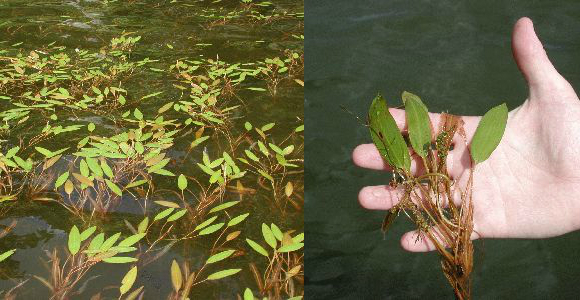
Coontail
Coontail, or sometimes called hornwort, is a dark olive-green, rootless submerged perennial plant that often forms dense colonies. Leaves are relatively stiff, whorled with many forks and small teeth along one edge. The tips of branches are crowded with leaves giving it a “coontail” resemblance.
Submerged portions of all aquatic plants provide habitats for many micro and macro invertebrates. These invertebrates in turn are used as food by fish and other wildlife species (e.g. amphibians, reptiles, ducks, etc.).

Eelgrass
Eelgrass, tapegrass, water-celery, or wild celery are all common names for Vallisneria. Eelgrass is a rooted submerged plant often found in flowing water. It has long, thin, ribbon-like leaves (1/2 – 3/4 inches wide) that are commonly 3 to 4 feet long and clustered. The vein pattern in the leaves of eelgrass is very distinctive and resembles celery.
Eelgrass seeds, roots and leaves are consumed by ducks and other waterfowl, while its dense underwater structures provides an excellent habitat for invertebrates and fish.
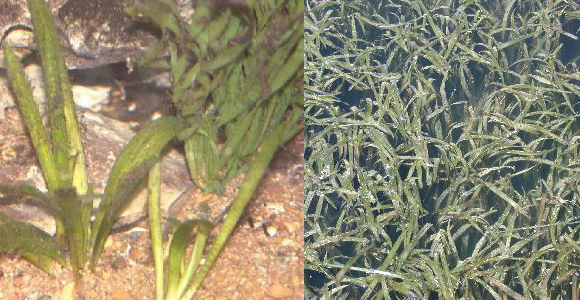
Emergent Species
American Lotus
American lotus is a perennial plant that is often confused with water lilies. Rhizomes are slender, branched, and rooted in mud. Leaves are simple, round, bluish-green in color, up to 2 feet in diameter, attached to the stem in center (no slit like water lilies). Leaves are flat if floating or conical if emergent and can stand above the water’s surface as high as 3 1/2 feet on the rigid stem. Flowers are large (to 10 inches across) yellowish-white to yellow with more than 20 petals.
The large acorn like seeds of lotus are utilized by some ducks and other wildlife.
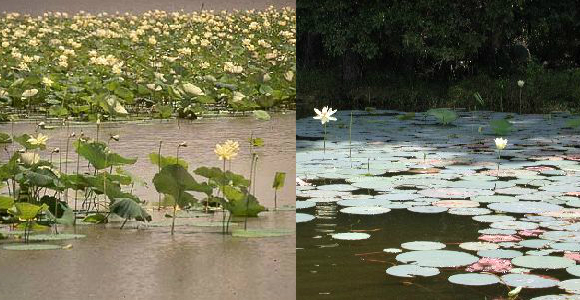
Cattail
Cattails have flat to slightly rounded leaves that twist slightly over their length and can grow to 5 or 10 feet in height. Flowers form a dense dark brown, cigar-shape at the end of spikes (called the catkin). Cattails can be partially submerged or in boggy areas with no permanently standing water. Cattails spread rapidly because their seeds blow in the wind and float on the water’s surface and vegetatively they spread from underground rhizomes.
The rhizomes and lower leaf portions of cattails are consumed by nutria, muskrats, and geese.
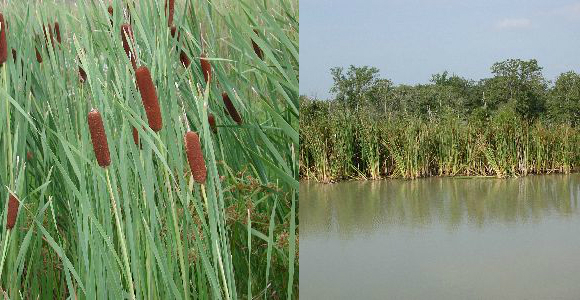
Giant Cutgrass
This perennial grass grows from rhizomes, producing stems up to 4 meters tall and 3.5 centimeters wide. The stems root at nodes that come in contact with the substrate. It also spreads via functional stolons (decumbent rooting stems) and vegetative buds that erupt from the stems. The blue-green leaves are up to a meter long and 3 centimeters wide. The panicles may exceed 80 centimeters long and are usually up to 20 centimeters wide.
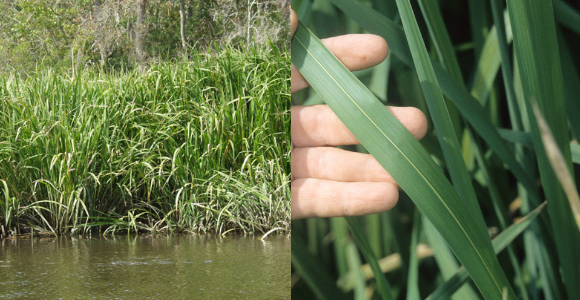
*Photos courtesy of University of Florida, Center for Aquatic & Invasive Plants
Maidencane
Maidencane can grow up to 8 feet tall and often forms dense colonies. It has long, narrowly tapered leaves(up to 12 inches long and 1 inch wide) with rough upper surfaces and margins. Flowers are on a long narrow spike (up to 12 inches long). Maidencane forms extensive rhizomes by which it spreads rapidly.
Submerged portions of all aquatic plants provide habitats for many micro and macro invertebrates. These invertebrates in turn are used as food by fish and other wildlife species (e.g. amphibians, reptiles, ducks, etc.). After aquatic plants die, their decomposition by bacteria and fungi provides food (called “detritus”) for many aquatic invertebrates. Muskrat and nutria will consume the rhizomes of maidencane.
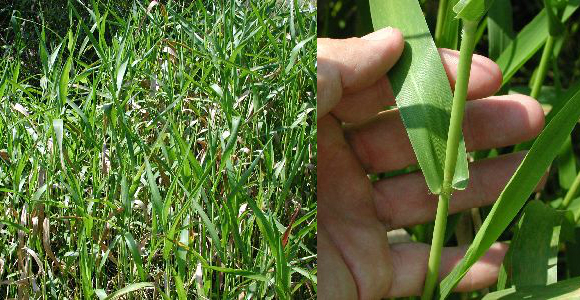
Water Primrose
Water primrose is a perennial plant that stands erect along the shoreline but also forms long runners (up to 16 feet) that creep across wet soil or float out across the water surface. These runners form roots at their nodes. Leaves range from lance-shaped or willow-like (2 to inches long by 1/2 to 1 inch wide) on the erect stems to round or oval 91 to 2 inches in diameter on the floating stems. Leaves can be green to reddish depending on the species. The single flowers are yellow with 4 or 5 petals depending on the species. Flowers vary in size from 1 inch to 2 inches in diameter.
Submerged portions of all aquatic plants provide habitats for many micro and macro invertebrates. These invertebrates in turn are used as food by fish and other wildlife species (e.g. amphibians, reptiles, ducks, etc).
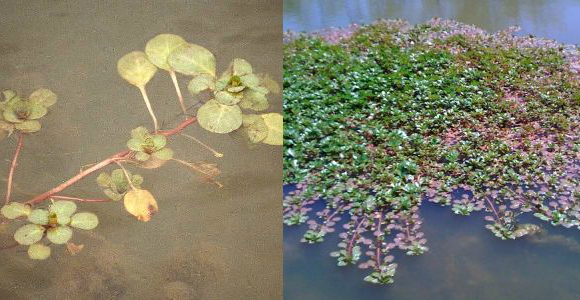
White Water Lily
Deer, beaver, muskrat, nutria and other rodents will consume the leaves and rhizomes of white water lily; while the seeds are eaten by ducks. Submerged portions of all aquatic plants provide habitats for many micro and macro invertebrates. These invertebrates in turn are used as food by fish and other wildlife species (e.g. amphibians, reptiles, ducks, etc). After aquatic plants die, their decomposition by bacteria and fungi provides food (called “detritus”) for many aquatic invertebrates.
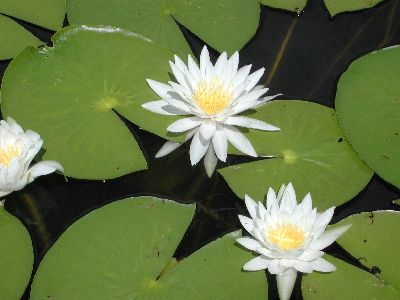
Algae
Filamentous Algae
Filamentous algae are single algae cells that form long visible chains, threads, or filaments. These filaments intertwine forming a mat that resembles wet wool. Filamentous algae starts growing along the bottom in shallow water or attached to structures in the water (like rocks or other aquatic plants). Often filamentous algae floats to the surface forming large mats, which are commonly referred to as “Pond scums.”
Filamentous algae has no known direct food value to wildlife.
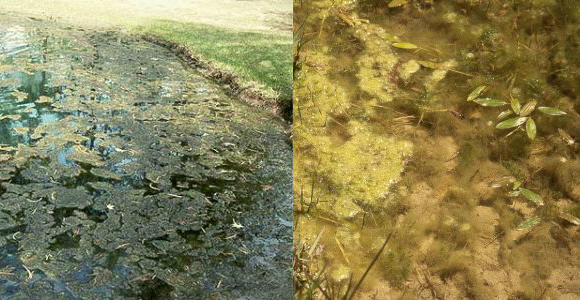
Exotic/Invasive Species
Requires an exotic species possession permit from Texas Parks & Wildlife for mechanical removal.
Alligator Weed
Alligator weed is a perennial plant native to South America and often forms very dense stands or mats that make shoreline access difficult. Aquatic stems are hollow and can be single or branched. Leaves are opposite, long, elliptical or lance-shaped up to 3/4 inch wide and 5 inches long with a prominent midrib. Roots often develop at leaf nodes. Soft, whitish hairs are found in the leaf axis. Flowers are singular, small (about 1/2 inch in diameter), white, fragrant clusters of 6 to 10 florets, borne on long branches (to 3 inches). The flowers resemble those of white clover. A single seed develops within the fruit.
This plant often forms mats. The mats can clog streams, canals, and ponds in coastal and eastern Texas.
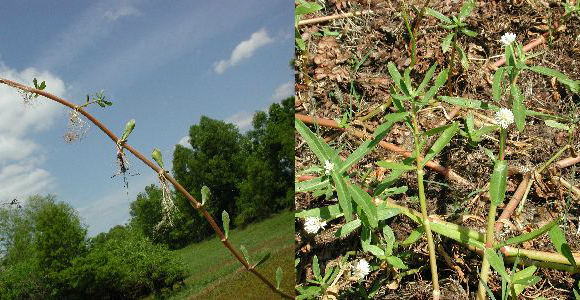
Hydrilla
Hydrilla is a perennial plant that forms dense colonies and can grow to the surface in water over 20 feet deep. Hydrilla branches profusely and after reaching the surface it extends across it forming thick mats. Hydrilla can reproduce by fragmentation, from seeds, from turions (axilary buds), and from tubers. Leaves are blade-like about 1/8 inch and 3/8 inch long with small tooth margins and spines on the underside of the midrib which make them feel rough. Leaves are usually 4 to 8 in a whorl. It is considered a noxious pest because it grows so rapidly, out competing and eliminating native species, and forming surface mats that hinder recreation, navigation, and water intakes.
Hydrilla turions and tubers are consumed by some ducks but generally it is not considered a good wildlife food.

All photos and plant descriptions courtesty of Texas A&M University. Additional photos and descriptions of these and other species of aquatic plants can be found here.
Who Are Our Partners
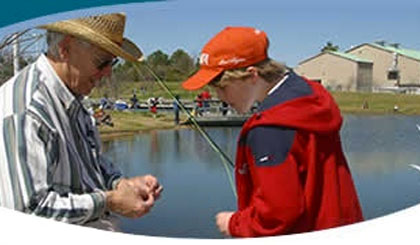
TX Freshwater Fisheries Ctr.
Visit the Texas Freshwater Fisheries Center website.
What's on our Minds

What the heck is the 448'?
If you've ever visited with our staff regarding improvements to your lakefront property, more than likely you've heard us mention the 448'. What is it?
What's Happening at Lake Athens

Upcoming Events
Here are a few events that may be of interest to property owners around Lake Athens.

